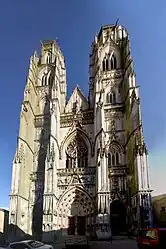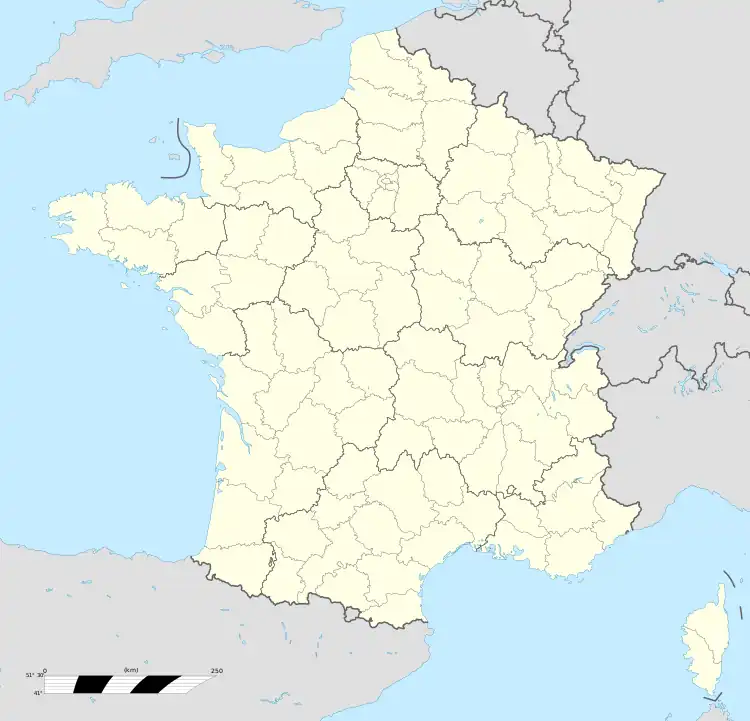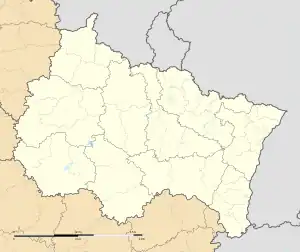Saint-Nicolas-de-Port | |
|---|---|
 The basilica in Saint-Nicolas-de-Port | |
 Coat of arms | |
Location of Saint-Nicolas-de-Port | |
 Saint-Nicolas-de-Port  Saint-Nicolas-de-Port | |
| Coordinates: 48°37′54″N 6°18′11″E / 48.6317°N 6.3031°E | |
| Country | France |
| Region | Grand Est |
| Department | Meurthe-et-Moselle |
| Arrondissement | Nancy |
| Canton | Jarville-la-Malgrange |
| Intercommunality | Pays du Sel et du Vermois |
| Government | |
| • Mayor (2020–2026) | Luc Binsinger[1] |
| Area 1 | 8.23 km2 (3.18 sq mi) |
| Population | 7,364 |
| • Density | 890/km2 (2,300/sq mi) |
| Time zone | UTC+01:00 (CET) |
| • Summer (DST) | UTC+02:00 (CEST) |
| INSEE/Postal code | 54483 /54210 |
| Elevation | 201–292 m (659–958 ft) (avg. 232 m or 761 ft) |
| 1 French Land Register data, which excludes lakes, ponds, glaciers > 1 km2 (0.386 sq mi or 247 acres) and river estuaries. | |
Saint-Nicolas-de-Port (French pronunciation: [sɛ̃ nikɔla də pɔʁ]) is a commune in the Meurthe-et-Moselle département in north-eastern France.[3]
The town's basilica, Saint Nicolas, is a pilgrimage site, supposedly holding relics of Saint Nicholas brought from Italy. It is one of France's Monuments historiques, and a minor basilica since 1950.
The town's inhabitants are known as Portois. In the past, the Portois were known as loudmouths; their neighbours across the Meurthe at Varangéville liked to gather on the opposite river bank to bombard them with a chorus indicating a wish to defecate in their mouths:
- Booyaî d'Senn 'Colais,
- Tend tet ghieule quand je...
which in the local Lorrain dialect means:
- Loudmouths of St Nicks,
- Open your gob when I'm taking a...[4]
St Nicholas-de-Port is also known for fossil remains of very early (late Triassic) ancestral mammals.

Population
| Year | Pop. | ±% p.a. |
|---|---|---|
| 1968 | 7,279 | — |
| 1975 | 7,490 | +0.41% |
| 1982 | 7,482 | −0.02% |
| 1990 | 7,706 | +0.37% |
| 1999 | 7,505 | −0.29% |
| 2007 | 7,597 | +0.15% |
| 2012 | 7,633 | +0.09% |
| 2017 | 7,520 | −0.30% |
| Source: INSEE[5] | ||
People
- André Joly (1706-1781?), court painter
See also
References
- ↑ "Répertoire national des élus: les maires" (in French). data.gouv.fr, Plateforme ouverte des données publiques françaises. 13 September 2022.
- ↑ "Populations légales 2021". The National Institute of Statistics and Economic Studies. 28 December 2023.
- ↑ INSEE commune file
- ↑ Graham Robb, The Discovery of France, p37, Picador (2007), ISBN 978-0-330-42761-6, citing Vital Collet "Sobriquets caractérisant les habitants de villages lorrains" in Le Pays lorrain, Nancy (1908), pp442-449 and Henri-Adolphe Labourasse, "Anciens us, coutumes, légendes, supersititions, préjugés, etc. du département de la Meuse" in Mémoires de la Société des lettres, sciences et art de Bar-le-Duc, 1902, pp3-225
- ↑ Population en historique depuis 1968, INSEE